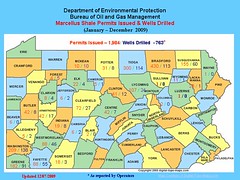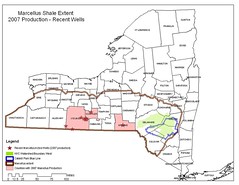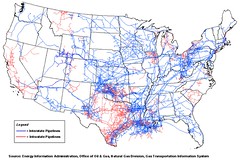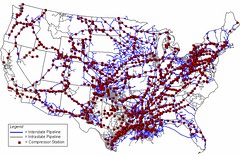When the natural gas companies descended on Pennsylvania's Marcellus Shale two years ago, it felt like a Gold Rush. And everyone seemed to be hitting pay dirt.
Landowners, many in long-depressed regions, rushed to lease their property, betting the promised royalties would better their lot. Mayors rejoiced that restaurants and hotels were full after decades of barely hanging on. Legislators talked of thousands of new jobs.
Even some environmentalists were pleased-natural gas burns clean, it's plentiful and it's local. Finally, it seemed, an energy source had come along that would wean Americans off their foreign oil addiction, fight climate change and boost the economy.
But now, with nearly 700 Marcellus wells drilled throughout the state, the environmental costs of drilling are becoming clear. The gas in the Marcellus "play" may ameliorate the United States' energy needs, but the technique to extract it has damaged streams, water supplies and Pennsylvania's famous forests. It has transformed some of the state's most beautiful landscapes into industrial zones and brought hardship to some who thought it was their lifeline.
No agency has tallied drilling's toll. But many environmentalists, legislators and citizens believe that, in its rush to drill, Pennsylvania was unprepared and unable to adequately review applications or inspect in the field. And in the end, it is not only the people in the watershed who will struggle, but the water itself.
"I don't have confidence that the state of Pennsylvania is where it needs to be," said Bernie McGurl, executive director of the Lackawanna River Corridor Association. "They're tripping over themselves to get well heads installed. We're going to have holes all over the northern tier of Pennsylvania. What is the implication of that long-term? They're going too far, too quick, with not enough oversight."
John Hanger, Secretary of the Pennsylvania Department of Environmental Protection, the main agency overseeing drilling, said the state was prepared. He dismisses criticism that the gas companies have too much influence on his agency as "absolutely crazy."
"We have an important responsibility here," he said, "and we're doing it every day."
Hanger acknowledged that natural gas drilling, like all energy production, has environmental costs. But, he noted, compared to coal and oil, natural gas releases fewer greenhouse gases that contribute to climate change and less nitrogen oxide that contributes to air and water pollution.
"If done right, (gas production) will produce much more good than bad," he said.
Three Problems
To reach the gas in the Marcellus, drillers must bore through dozens of geological formations. Then, workers pump into the well millions of gallons of water mixed with sand, salt and a cocktail of chemicals to fracture the gas-bearing rock. This process, known as hydraulic fracturing, or "fracking," was pioneered by energy giant Halliburton in the 1940s. The gas flows from the broken rock out of the well to a compressor.
With it comes about one-fifth of the water that was pumped in, bearing the chemicals used in fracking and radioactive elements that occur naturally in the rock. The remainder of the water stays deep in the formation-well below drinking water aquifers, according to regulators and energy companies.
The drilling and fracking process presents three water-related problems.
The first is withdrawals. Gas companies need about 5 million gallons to frack each well. They pull the water from streams, and because nearly three-quarters of the Marcellus is in the Susquehanna River basin, much of that water has and will come from those feeding the Bay's largest tributary. The companies have occasionally pulled water from small headwater creeks that are slow to refill, which can change temperatures and oxygen levels and endanger fish.
The second is the fracking wastewater, called flowback, which is usually stored in a plastic-lined impoundment before it can be trucked to a treatment plant. Critics worry that the wastes could spill during transit or operations and run into waterways or seep into groundwater.
Earlier this year, Texas-based Cabot Oil Co. spilled 8,000 gallons of fracking waste into Stevens Creek, a tributary of the Susquehanna River in the northeast Pennsylvania hamlet of Dimock.
Because fracking waste can have five times as much salt in it as ocean water, groups such as Trout Unlimited worry that accidents like that will forever change the ecology of fresh, coldwater streams.
The third problem is groundwater contamination from methane accidentally released through the drilling. Today, at least 13 families in Dimock, home to more than 63 of Cabot's gas wells, can't drink their well water because it contains methane. Methane contamination has been reported in other states where drilling has occurred, and critics worry it could become a bigger problem in Pennsylvania.
The DEP has fined Cabot nearly $200,000 in connection with both the spills and the well water contamination.
"How big is this thing?"
Gas company executives had long been aware of the Marcellus, which sprawls across parts of New York, Pennsylvania, Ohio and West Virginia and small sections of Maryland, Virginia, Kentucky and Tennessee, but weren't excited about it. At close to 8,000 feet deep, extraction was difficult and costly.
But in the 1990s, workers in Texas' Barnett Shale began using a technique called horizontal drilling coupled with hydraulic fracturing. In this process, workers drill down until just above the target layer. Then they turn the drill to the horizontal so the well runs parallel through the gas-bearing layer, yielding significantly more gas than a vertical well.
Range Resources drilled the first horizontal Marcellus well in western Pennsylvania in 2003. By 2007, when Range released results from three horizontal wells, the industry stirred. The next year, two geologists-Penn State University's Terry Engelder and State University of New York-Fredonia's Gary Lash-published a paper showing that the Marcellus had enough natural gas to supply the whole country for two years.
"That's when the whole world said, 'Whoa, how big is this thing?'" recalled Range spokesman Matt Pitzarella. "And that's when the land grab occurred."
Since the original estimates were made, new estimates, based on the success rate of the wells so far, put the amount of gas available much higher.
A Rush for Leases
Landmen, gas company representatives intent on negotiating leases, fanned out across states in the Marcellus Shale offering signing bonuses and royalties. Typically, companies assemble a large area and then decide where to put wells, well pads and other infrastructure.
In Maryland, some landowners in Garrett and Allegany counties signed leases, and while a drilling company has requested permits for four wells, none have been drilled.
Drilling did begin in New York. But last year, as concerns grew about treating the waste and protecting New York City's water supply, Gov. David Patterson announced an overhaul of the state's environmental laws. He declined to issue any more Marcellus permits, leading to a de facto moratorium.
Pennsylvania, in contrast, ramped up. Last year, 451 companies applied to drill-almost five times more than all of the applications between 2003 and 2007.
In April, the agency took the soil and erosion control permitting away from the county soil conservation districts to make the process more efficient and, Hanger said, more effective.
Water Withdrawal
As drilling began, the water grab followed the land grab. Trucks backed up to small streams, sucking out thousands of gallons at a time.
In much of Pennsylvania, such withdrawals are regulated by the Susquehanna River Basin Commission, while the DEP regulates water quality. The commission is an independent agency, with representatives from New York, Maryland, Pennsylvania and the federal government, created to guide the conservation, development and administration of the vast basin's water resources.
The withdrawals "took us by surprise," said Paul Swartz, the commission's executive director. "Frankly," he added, "It has taken some time to get on top of it."
Under the commission's nearly 40-year-old rules, companies could take less than 100,000 gallons of water per day without a permit. Some were taking close to that amount daily. And even if they took less, the commission would have a hard time checking. So, it changed the rules. If a company took as much as one gallon, it needed permission.
Next, the commission sent letters to the nearly two dozen gas companies operating in the basin, warning them to get withdrawal permits or face steep fines. They meant it. Cabot had to pay $75,000. Another company, Chief Oil and Gas, paid $250,000. Range was fined a whopping $475,000 for its violations, which Pitzarella attributed to "a lack of knowledge."
"We fixed it," said Pitzarella, whose company now has 900,000 acres under lease in the Marcellus Shale. "We want to make sure that never happens again to us."
The commission has been inundated with withdrawal applications, processing as many as four times the number it did a year ago even as the commission's budget has been slashed. To cope, it raised the application fees and added staff.
While they've approved nearly every permit, officials say they do a lot of negotiating, steering drillers away from headwater streams that do not easily replenish.
"There are a number of concerns about where we are today," Swartz said. "And where we are is not where we need to be, from an environmental perspective."
The commission has been monitoring sites along the Susquehanna for nitrogen and phosphorus since the 1980s, providing their analyses to the DEP so the agency can enforce environmental laws. It now wants to expand that network into smaller streams in the drilling area and to test for fracking chemicals. To do that, it's seeking $750,000 in government or other grant funding.
Water as Waste
The chemical mixes that make up the fracking fluids break up the rock, keep the fractures open and protect the well from corrosion and bacteria buildup. They include carbonates, methanol, hydrochloric acid and anhydrides, as well as high concentrations of salts. The mixes vary from well to well, depending on the nature of the shale beneath. The gas companies say their specific nature is proprietary.
A 2-decades-long effort to require the companies to reveal more about the fracking compounds and impose broader controls on their use continues. It began in 1989, when some Alabama residents filed a lawsuit alleging that gas drilling contaminated their well water.
In 1997, the U.S. Court of Appeals ordered the EPA to regulate fracking fluids under the Safe Drinking Water Act. But the industry, led by Halliburton and its then CEO, Dick Cheney, pushed back. By the time the EPA began studying the issue, Cheney had become vice president of the United States and taken a lead role in crafting energy policy.
By 2004, the EPA had decided that fracking fluids were not of sufficient concern to regulate. The following year, Congress exempted fracking from the Safe Drinking Water Act.
Since then, environmental groups have been lobbying Congress to close what they call the "Halliburton loophole," pointing to cases of rare cancers popping up in areas of intense drilling and other serious health concerns. In October, Congress passed, and the president signed in November, legislation ordering the EPA to re-examine the impacts of fracking on drinking water.
U.S. Sens. Bob Casey, D-PA, and Charles Schumer, D-NY, have introduced the Fracturing Responsibility and Awareness of Chemicals Act, known as the "FRAC Act," which would regulate the practice under the Safe Drinking Water Act and require disclosure.
So far, no action has been taken, although a handful of CEOs -Range's included-have suggested that the industry voluntarily disclose that information.
Stephen W. Rhoads, the longtime president of the Pennsylvania Oil and Gas Association, said the fracas over fracking is overblown, and some regulators agree.
"We asked the companies what was in it on day one, and they told us on day two," said Michael Brownell, chief of the Susquehanna River Basin Commission's water resources management division.
The DEP's website provides a three-page list of chemicals found in fracking fluids. Asked to identify which were worrisome, DEP spokeswoman Teresa Candori said, "All chemicals are of concern."
Knowing what chemicals are in the fluid is one issue; treating them is another.
Currently, no wastewater plant in Pennsylvania can adequately treat the mix of chemicals and minerals that come from the drilling operations.
Earlier this year, after high levels of chemicals associated with fracking turned up in the heavily industrial Monongahela River, the DEP ordered that, by 2011, any plant that takes fracking waste must be able to clean it well, and that it would not issue new permits until the plants could. But it let the plants that had been taking the waste continue to do so while they improved their capabilities-so long as they didn't increase their amounts. Two of those plants-Williamsport and Sunbury-are in the Susquehanna watershed.
Asked for a measurement of the volume of water treated, Candori said, "At this time the department does not have an accurate accounting as to what wastewater is being received by existing facilities for treatment."
A few companies want to build new facilities to treat the chemicals. One would discharge directly into the Susquehanna at Tunkhannock, and another just north of it in Messhopen Creek. But some scientists say the treatment technology is untested. And residents and the Pennsylvania Fish and Boat Commission say the river can't take more stress.
"I am totally against the discharge of pollutants into the Susquehanna River or any of its tributaries," said Richard Fitzsimmons, a former Wyoming County commissioner. "It does not belong in the streams of Pennsylvania."
Further complicating the issue is uranium, which has long been known to occur naturally in the Marcellus Shale. According to ProPublica, a public interest news organization, recent tests in New York showed that levels of radioactivity in the fracking fluids that returned to the surface were 267 times higher than the limit for safe discharge into the environment. New York health officials said handling radioactive wastewater "could be a public health concern," and many plants wouldn't be able to accept it. One gas company official told ProPublica that, if plants declined to treat their water, they would have to shut down.
The DEP tested shallow gas wells for radioactivity in the 1990s and found only two sites that might be of concern, according to an agency report. The DEP is continuing to study the issue, Candori said.
The industry is looking at options beyond treatment plants, such as recycling the water or storing it in deep-injection wells.
"The concern now is with the volume," Rhoads said. "It's true there will be a need to manage those water flows."
A Well in Pieces
On New Year's Day, Dimock resident Norma Fiorentino left her trailer to visit her ailing daughter. When she returned, her water well was in pieces, blown apart by methane that had seeped into her well. From her faucets, orange water bubbled.
Down the road, Victoria Switzer's water looked like orange Alka-Seltzer. Well by well, Fiorentino says, neighbors lost what had long been pristine drinking water.
DEP tests confirmed elevated methane levels. It declared Cabot was responsible, faulted the company for poor record-keeping and polluting the groundwater, and required that it install methane detectors in several homes-although Fiorentino never got one. The DEP also said the gas in the water didn't pose a danger.
Still, Fiorentino wasn't going to drink it. A widow on a fixed income, she begged Cabot to bring her bottled water. They refused.
Cabot lawyer and spokesman Ken Kamoroski said the company declined because "the water supply was determined to be safe by the appropriate regulatory agencies."
The New Year's Day explosion galvanized residents and environmentalists, who had long been distrustful of both the state and the gas companies and who worried that the mistakes in Dimock could be repeated as the drilling boom spread.
Their list of grievances was long. Because of budget cuts, they charged that the DEP had become little more than a rubber stamp; it had taken the job of permitting for soil and erosion away from the county soil districts, but it lacked the expertise to do the job itself. Several DEP staffers had left the agency for gas company jobs, a fact the agency acknowledges. And, with a budget crisis and a prolonged recession, environmentalists feared the DEP was under pressure to cave to the gas industry.
DEP officials insisted they were doing their jobs. Candori, the DEP spokesperson, said agency employees make "frequent and unannounced visits" to drilling sites, and conducted 10,365 inspections this year. And Hanger said one of his first orders of business was to raise the permit application fees so he could hire more staff.
Matthew Royer, an attorney with the Chesapeake Bay Foundation, decided to check their work. In September, he reviewed a batch of recently approved permits. One proposed building a pipeline across a wild trout stream. Another proposed a pipeline across high-quality trout streams in the Pine Creek watershed, which also includes Pennsylvania's Grand Canyon. The third asked to drill in the Tioga State Forest.
"They're not doing any on-site checking at all," Royer said. "You can catch some deficiencies by looking at the paperwork, but they weren't even doing that."
Despite the agency's claims of tough oversight, it revoked all three contested permits in late October, citing "technical deficiencies." In all three cases, the gas companies and their consultants had given incomplete or inaccurate information.
Royer wasn't doing a victory dance; the DEP also ordered the drilling companies to "halt earth disturbances"-meaning that some of the pristine areas had already been altered. And the agency wasn't budging on the larger issue of giving the authority for issuing permits back to the county soil conservation districts.
"This is environmental protection after the fact," Royer said. "I have not heard from DEP any indication where they're willing to do the reviews...so we will look at more permits. We will appeal more. This can go on and on."
Hanger calls the foundation's views misguided.
"I would be the first to say that the practices that were brought to our attention, in the field, were not appropriate...and we revoked the permits," he said, adding, "Let's be clear who has the greater ability to enforce. It's us. We want to get this industry to the point where they know they are being watched."
Drills in the Night
In Dimock, Victoria Switzer was watching something else-the rural hamlet where she and her husband were building their dream house had become an industrial zone. She lay awake at night as Cabot drilled. Water trucks trundled down dirt roads, while pickups with Texas license plates sped by. The great horned owls left, and her favorite hiking trails were marked with "no trespassing" signs and fluorescent ties.
And accidents continued. State records show a diesel spill in February and three subsequent drilling mud spills, two of which reached Burdick Creek.
Like Fiorentino, Switzer couldn't drink her water nor convince the gas company to buy her bottles. She said she felt like a tenant, with a very bad landlord. It was, she said, "just one nasty surprise after another."
On Sept. 16, Switzer organized a meeting to press Cabot for water. That same day, Cabot had two spills at its Heitsman well, and a third one there a week later. In all, 8,000 gallons of fracking fluid spilled into Stevens Creek, causing a fish kill.
Though he said the spills were at least least 99.5 percent freshwater, Kamoroski acknowledged that "three spills in the same area are completely unacceptable."
In October, the DEP fined Cabot $56,000 and ordered the company to temporarily halt fracking operations. By month's end, on the day the Scranton Times published an article on Switzer's and Fiorentino's woes, Cabot promised them bottled water.
Last month, DEP ordered Cabot to provide a permanent water solution to Fiorentino, Switzer and 11 other families. It fined the company another $120,000 and set up a tighter inspection schedule for well casings, pipelines and other infrastructure.
Kamoroski still questions whether Cabot caused the water problems. Nonetheless, the company signed the agreement accepting responsibility.
"We're aware the Dimock situation has not been helpful to our overall effort," he said. "We want to earn everyone's confidence and belief that drilling is safe, and we can build a track record that demonstrates that."
Norma Fiorentino and Victoria Switzer are not likely to become believers.
"The regular folk out here will never see the compensation they deserve, and their original water supply is forever gone," Switzer said. "I'm never going to make any money on this. All I've lost is my soul."
Update
Just before Thanksgiving, 15 families in Dimock filed a lawsuit against Cabot for contaminating their drinking water and their land and causing illnesses of the digestive system, the nervous system and the skin.
Among the plaintiffs are Norma Fiorentino and Victoria Switzer. Cabot spokesman Ken Kamoroski told the local press last week that the claims had not merit and that he was ³disappointed² they had decided to sue. The suit was filed in Pennyslvania Middle District Court in Scranton.
Dimock residents have said the lawsuit was a last resort for justice, after failing to get the attention of their legislators or the Pennsylvania Department of Environmental Protection.
Around the same time as the lawsuit was filed, another state agency stepped up to tighten enforcement and monitoring. Beginning this month, the Pennsylvania Fish and Boat Commission will monitor natural gas wells that are close to wetlands and waterways. The commission will report this information to the DEP, which can take the proper enforcement action.
Until now, the commission only looked at Marcellus wells in response to complaints, and many citizens complained they were not being proactive.
According to the Pittsburgh Post-Gazette, the issue over whether to monitor Marcellus wells became so contentious that board members asked executive director Doug Austen to resign in part because of it. He's expected to leave early next year.



















Dupont Hydro is a leading manufacturer and exporter of Hydraulic Grab and also one of the leading Hydraulic Grab supplier.
ReplyDeleteThanks for sharing. i really appreciate it that you shared with us such a informative post..
ReplyDelete